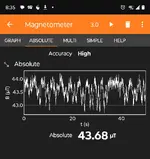Midden-marauder
Sr. Member
- #21
Thread Owner
Oh, and in case any of you are curious to try messing with this the apps I've been using with are: phyphox (best analytical app that I've found), physics toolbox, keuwlsoft AC magnetic meter, keuwsoft gauss meter, crowdmag, Lord Kelvin sensor logger, magnetometer 3d, and an assortment of compass apps (the steel compass app is the most useful) to help confirm calibration and avoid major heading errors while interpreting data. Avoid basically all of the so called metal detecting apps, they all appear to have been programmed by folks who don't actually really understand what a magnetic sensor does. The so called EMF reader apps are all mag apps but it's not an emf meter in the classic sense, these apps are so so at best.
I'd seriously love to see mags as standard metal detector features, it's a fairly powerful tool
I'd seriously love to see mags as standard metal detector features, it's a fairly powerful tool
Last edited:



 lol
lol
